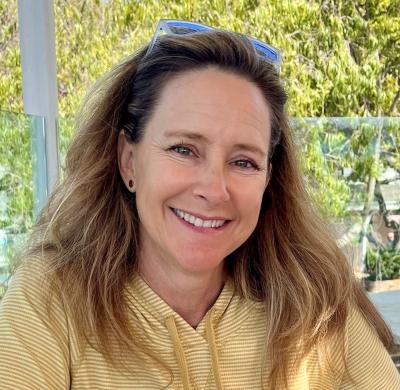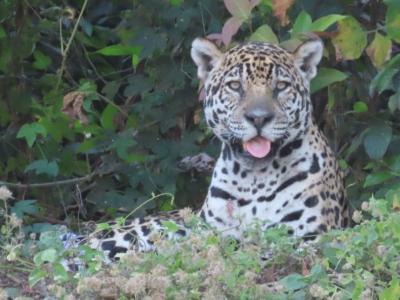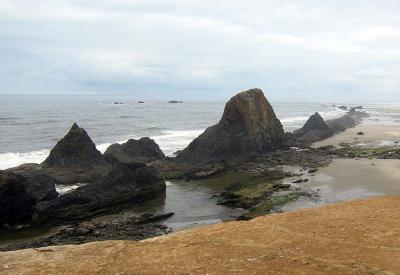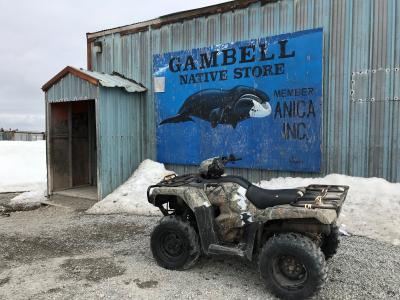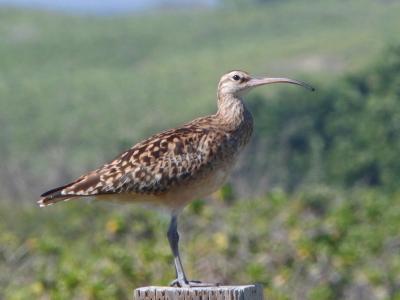Oregon: Birds and Theater
-
Sep 1-7, 2025
Rich Hoyer
2025
Single Room Supplement: $790
2025
Single Room Supplement: $790
This tour is a marvelous mix of western North American combined with one of the West Coast’s top cultural attractions in a small and surprisingly civilized town. On four days, after a glorious morning of birding that includes Rich’s famously delicious picnic breakfasts and lunches in stunningly gorgeous surroundings of mountain meadows and coniferous forests, we’ll return in time for a daily performance in the theaters just four short blocks from our comfortable hotel. We’ll have the opportunity to see four of the year’s offerings, including at least one Shakespeare play. (We’ll update the offerings once OSF announces their 2025 schedule.)
First of all, it’s not just a festival and far more than just Shakespeare. The Oregon Shakespeare Festival began as a three-day event featuring two Shakespeare plays, but that was 85 years ago. Away from the Pacific Northwest it seems to be a closely-guarded secret, but the OSF has evolved to be one of North America’s premier acting companies. In recent years, over 800 performances during their eight-month season were viewed by 400,000 attendees. Now offering up to ten different plays over the season and occupying three stages, the Tony Award-winning OSF doesn’t have trouble selling out performances, especially during the summer, when nearly perfect weather occurs with almost alarming predictability.
The delightful setting of Ashland is often underappreciated by its loyal theatergoers, many of whom make an annual pilgrimage from throughout Oregon, Washington, and California to see all the plays in just a few days. It is located in a natural wonderland, hours from any metropolitan area and surrounded by rugged mountains, wild rivers, national forests, and wilderness areas, and it’s within driving distance of Oregon’s only national park (Crater Lake, which we visit), a national monument, and several national wildlife refuges. Despite this, Ashland is also a charming and surprisingly civilized small college town with many fine restaurants within walking distance of our hotel; we’ll sample a different one each night.
(This tour can be taken in conjunction with our tour Oregon in Summer.)
Day 1: Our tour begins with a 4pm pickup at the airport and then an introductory meeting at 5:30pm at our hotel in Ashland followed by a walk to dinner.
Days 2-4: Our first birding will likely be near Ashland in a valley surrounded by forested hills. The oak and madrone woodlands are home to the common California Scrub-Jay along with the more local California and Spotted Towhees, Oak Titmouse, White-breasted Nuthatch, and Acorn Woodpecker. Bushtit, Lesser Goldfinch, and Black-capped Chickadee are common garden birds in town, and even American Dipper can be found in the city park. As we wander farther from town, the back roads through mixed conifer forests are good for Mountain Quail, Sooty Grouse, and Northern Pygmy-Owl, three of the harder to locate western specialties. Options for other birding days might include Mt. Ashland, where wildflowers attract several kinds of butterflies and searching for Great Gray Owl, which breeds in all the surrounding mountains. If we have the energy, we can even spend a few post-theater minutes looking for Western Screech-Owl in the park behind the theaters or even driving farther for Flammulated or Northern Saw-whet Owl. We’ll be back each day for our scheduled 1:30 pm or 8:00 p.m. theater performance. Nights in Ashland.
Shows:
- 2 September, 1:30 pm, Julius Caesar
- 3 September, 1:30 pm, Shane
- 4 September, 1:30 pm, The Importance of Being Earnest
Day 5: We’ll take a break from the theater to travel a bit farther abroad into the Klamath Basin, famous for its teeming national wildlife refuges. Along our route are diverse coniferous forests where we should see Dusky Flycatcher, White-headed Woodpecker, Cassin’s Vireo, Pygmy Nuthatch, Mountain Chickadee, and Mountain Bluebird. We’ll drive around the enormous Upper Klamath Lake in search of Ruddy Duck, Western and Clark’s Grebes, and American White Pelican. Staying overnight far from civilization among pine forests and sedge meadows, we’ll enjoy a home-grilled dinner on the patio. Afterward we may take a short trip to look for owls. Night in Fort Klamath.
Day 6: We’ll visit magnificent Crater Lake National Park this morning, checking the coniferous forests on the way up the mountain for Williamson’s Sapsucker and Cassin’s Finch. Birding above treeline at the lodge and the rim overlooking the crystal blue lake (the deepest in North America) could produce Clark’s Nutcracker, Canada Jay, and possibly Gray-crowned Rosy-Finch. It will be a memorable day in one of the most scenic national parks in the country. In the afternoon we’ll return to Ashland and the festival in time for our farewell dinner and attend a final evening performance. Night in Ashland.
Show:
- 6 September, 8:00 pm, Quixote Nuevo
Day 7: The tour ends this morning in Ashland
Note: The information presented here is an abbreviated version of our formal General Information for Tours to Oregon: Birds and the Shakespeare Festival. Its sole purpose is to give readers a sense of what might be involved if they took this tour. Although we do our best to make sure that what follows here is completely accurate, it should not be used as a replacement for the formal document which will be sent to all tour registrants, and whose contents supersedes any information contained here.
ENTERING THE UNITED STATES: Non-U.S. citizens will need a valid passport and may need a tourist visa. Consult your nearest U.S. Embassy or consulate for details. Canadian citizens should carry proof of citizenship in the form of a passport or birth certificate.
PACE OF THE TOUR: Most mornings will start around 6:00 a.m.; a few may begin earlier. On three days we finish birding at our picnic lunch, returning to the hotel in time for the afternoon play. A short afternoon walk to the nearby park may be offered on one day, and optional owling will be offered on a couple nights after dinner. On our two days to the Klamath Basin and Crater Lake we have longer days in the field, returning to the hotel by about 4:00 p.m. with an hour or two off before dinner and a late evening play on the return day.
The walk from the hotel to the theater complex is four blocks on sidewalks.
There are no particularly long or strenuous walks, the longest being no more than a mile. Most walking is done on roads and level trails, although there will be some over uneven ground and possibly in marshy/dewy grass. When looking for Great Gray Owl, we may have to walk through a forest up a slope with much fallen wood, requiring good balance and agility. One can opt to stay on the road near the van during this short walk if it is too difficult. Having sturdy footgear, waterproof if possible, is important, and a walking stick is recommended for anyone with balance problems or weak knees.
HEALTH: Oregon presents no real hazards to the visiting birdwatcher.
Insects: We will be in Oregon largely after the mosquito season. The leader will have enough repellent for all if it seems necessary.
Elevation: Some of our birding is at elevations of 6000 to 7500 feet, and while we do not schedule anything even faintly strenuous at these elevations, anyone with a history of cardiovascular or respiratory problems should be aware of the altitudinal stress. Please consult your physician.
Smoking: Smoking is prohibited in the vehicles or when the group is gathered for meals, checklists, etc. If you are sharing a room with a nonsmoker, please do not smoke in the room. If you smoke in the field, do so well away and downwind from the group. If any location where the group is gathered has a stricter policy than the WINGS policy, that stricter policy will prevail.
Miscellaneous: We actively look for reptiles, but the one species of poisonous snake in Oregon is very seldom seen this early in the year. High-elevation sun can be intense, making a broad-brimmed hat, proper clothing and a strong sun block lotion essential.
CLIMATE: It could be cool in the early mornings in the mountains and hot down in the valley: we may experience temperatures ranging from 40° to over 100°F, with averages ranging 55° to 85°F. Rain is unlikely at this time of year.
ACCOMMODATIONS: We will stay at a standard, comfortable motel while in Ashland; our cabins for the one night at Fort Klamath are nice and clean, but simpler, tending towards rustic.
Internet: Wireless internet will be available at both hotels.
FOOD: Food is North American standard but Ashland has some nice restaurants, and fresh fruit and produce are everywhere available. At Fort Klamath we will have a fresh grilled dinner prepared by your leader. There will be plenty of fresh fruit and vegetables, mostly organic, at our picnic meals.
WINGS tours are all-inclusive and no refunds can be issued for missed tour meals.
Food Allergies / Requirements: We cannot guarantee that all food allergies can be accommodated at every destination. Participants with significant food allergies or special dietary requirements should bring appropriate foods with them for those times when their needs cannot be met. Announced meal times are always approximate depending on how the day unfolds. Participants who need to eat according to a fixed schedule should bring supplemental food. Please contact the WINGS office if you have any questions.
Water: Tap water is potable throughout. Fresh water will be available in the van throughout the tour, usually in one-gallon containers. It is suggested you bring your own personal water container so as to have a continuous supply of water in order to stay hydrated at all times.
TRANSPORTATION: We will be traveling by 15- (or 12-) passenger window van or minivan, depending on the group size. When using 15-passenger window vans, we take a maximum of seven passengers plus the leader. Some roads may be quite bumpy and/or winding; anyone susceptible to motion sickness should bring an appropriate remedy. Participants should be able to ride in any seat in tour vehicles and are expected to change seats with others daily.
2023 Narrative
Brief Summary
For such a short, compact tour, we packed it in – great birding in with gorgeous scenery, terrific restaurants with delicious variety, and of course some top-notch performances by the Oregon Shakespeare Festival all combined to make this a memorable tour. Though evenings were usually very smoky from distant forest fires in California, our birding up in the mountains was in fresher air, and the side trip to the Klamath Basin and Crater Lake National Park was simply perfect. Owls and woodpeckers were a recurring theme, with Barn Owl, Northern Pygmy-Owl, Acorn Woodpecker, and White-headed Woodpecker among the top five favorite birds. We were surprised by two Ruffed Grouse in the road one morning, which also received multiple votes. Because of the smoke, we missed the two performances in the outdoor Elizabethan theater, but the three we saw indoors were outstanding, with Where We Belong on its opening night a favorite for most of us – even though the only Common Grackle we would see during the tour was on its promotional poster.
In Detail
Our first day of birding showed that nearly everything in the mountains seemed to have had a good year for breeding success. We scored big on quality and quantity of so many species, starting with an eBird-flagged covey of at least 20 Mountain Quail right on the shoulder of the road. The next stop was just a minute farther down the road where somewhere between 400 and 500 Cedar Waxwings were perched in a big tree, presumably resting between feasting on the abundant bitter cherry and blue elderberry on the brushy slopes below the highway. There were many other birds at this stop, including both Cassin’s and Purple Finches and a Nashville Warbler, but the highlight was the Northern Pygmy-Owl that only very slowly responded by inching closer, remaining out of sight. But when it did appear, it was just a few yards away not far above eye level, in plain sight, where it sat for so long, we eventually drove off leaving it perched in the open. Later in the morning we encountered some mixed flocks that were teeming with Red-breasted Nuthatches, with a scattering of other species, such as Chestnut-backed Chickadee. A perched-up MacGillivray’s Warbler was a great find, probably a bird still on its breeding territory, while later in the morning a Red-breasted Sapsucker in its muddy juvenile plumage was seen. At picnic lunch we spied a wayward Pygmy Nuthatch, and then on our way back to Ashland made a stop at Emigrant Lake. A Golden Eagle on a power pole took us by surprise, clinching its ID only after it took flight and showed us field marks and its distinctive shape – and then it was joined by a second bird. At the lake’s edge we sifted through a few species of migrant shorebirds, including two Red-necked Phalaropes on the water. Birding wasn’t quite over back at the hotel, as an Acorn Woodpecker perched in the trees and the same Rufous Hummingbird we first spotted yesterday continued to defend the flower beds from his powerline perch. Once we learned that our play was canceled due to smoke, we offered a short owling excursion by foot up into the nearby Lithia Park. As dusk descended, we noted Common Nighthawk and some bats before it was dark enough to start whistling for Western Screech-Owl. Two birds flew in quietly but were spotted by some very sharp eyes in the group, and we ended up with wonderful views of them in the park’s old trees right overhead.
A short morning of birding close to the Rogue River near Medford was productive, providing some of our only sightings of lower-elevation riparian and oak woodland species. Acorn Woodpeckers drew our attention with their noises and abundance, but also because their main granary tree was a magnificent ponderosa pine stump filled with thousands of acorns. Yellow and Black-throated Gray Warblers joined the mixed flocks that contained Oak Titmouse and Bushtit, while a single Yellow-breasted Chat was a good find in a willow thicket. A pair of Wrentits showed no fear at all where we also saw a Belted Kingfisher over the Rogue River. The newly created White City Lagoons were active with shorebirds, including a rarish Solitary Sandpiper, while the weedy areas held Lesser Goldfinches and Western Meadowlarks. We caught sight of our only Northern Rough-winged Swallows here, and a Loggerhead Shrike along with a Northern Mockingbird were good finds in the fencerow. We were back to Ashland in time for lunch followed by our first show, a creative setting for Romeo and Juliette. A few took an opportunity to look for Flammulated Owl in the mountains just west of Ashland, where we heard one very close bird that was too reluctant to come out in the open.
We made an early departure for our mid-week “weekend” over to the Klamath Basin in hopes that a Great Gray Owl would be still out hunting, but the favored meadows still were free of owls, though we did finally catch up with our first Hairy Woodpecker there. Five warblers of five species and a Cedar Waxing in one tree was a highlight at our picnic breakfast spot, while driving a back road paid off in the form of two Ruffed Grouse standing in the road for both vans to see. Roadside stops included a perched adult Bald Eagle, Osprey, and Yellow-headed Blackbirds mixed in with Red-winged Blackbirds, as well as wetland birds such as American Avocet, Black-necked Stilt, and countless ducks. At lunch, an American Kestrel showed nicely, while a pair of Rock Wrens was coaxed off the tall cliffs nearby. We drove around the impoundments of Tule Lake National Wildlife Refuge teeming with birds, including many Eared and Western Grebes. One last stop to admire the petroglyphs in a part of Lava Beds National Monument resulted in our spotting a pair of Barn Owls nestled comfortably in one of the many nooks in the eroded tuff. We arrived in good time at our lovely motel in the woods and meadows of Fort Klamath for the leaders to prepare a delicious grilled vegetable and chicken fajitas dinner with homemade premium chocolate mousse for dessert.
We birded the meadows and forests near our lodge, finding a migrant group of Violet-green Swallows on the power lines while flushing many Savannah Sparrows along the roadside and pausing for a surprising number of immature Red-tailed Hawks of all color morphs. Bald Eagles graced the mountain meadows nearby, and a pair of Sandhill Cranes fed peacefully near the forest edge. Up in the national park, a pair of Clark’s Nutcrackers foraged around the gift shop at Crater Lake before we walked over to the crater’s edge to gaze in awe at the blue depths below. We made several stops around the part of the rim drive, spotting another Clark’s Nutcracker, an unexpected Band-tailed Pigeon, and a flyover Lewis’s Woodpecker. As we were driving out, an American Goshawk flew alongside the vans and quickly disappeared. Lunch was eventful for the confiding and clever Canada Jays that grabbed nuts from our open palms. A stretching stop at Rocky Point boat ramp on Upper Klamath Lake yielded a lovely Western Tanager and a Green Heron, and a detour to look for woodpeckers in the Fourmile Lake area was good only for Mountain Chickadees, Yellow-rumped Warblers, and Red-breasted Nuthatches. With the evening showing of Twelfth Night canceled, we had replacement tickets for Where We Belong, a wonderful one-woman performance giving us a Native American perspective we usually aren’t given an opportunity to consider.
Our final morning of birding took us to the south-facing slopes of Mount Ashland south of town. We first surprised Wild Turkeys on the road before meeting up with local birders and friends Karen and Keeley at the campground for picnic breakfast. Green-tailed Towhee and Lincoln’s Sparrow were a couple of the prizes we teased out of the dense, brushy slopes, but frequent passing of one or more Cooper’s Hawks often kept birds down, perhaps including the Dusky Flycatcher that we only heard. We finally connected with a lone White-headed Woodpecker, enjoyed several Steller’s Jays, and then at the very top of the mountain saw a few Mountain Bluebirds minus any fully-colored males. On the way back down into the valley we flushed a covey of California Quail, then made a stop at Emigrant Lake where a rare Forster’s Tern was attracting local birders. Another Solitary Sandpiper here was a good find, and a California Towhee made a final appearance as we were leaving. We had another afternoon show today, first saying hello to our friend the Rufous Hummingbird that daily guarded the bed of salvia flowers on the hotel grounds, then enjoying a superbly performed Rent, followed by a top-notch farewell dinner at an Italian restaurant.
Birding wasn’t quite done for some on our morning of departures. We offered an optional 5:30 departure up and down the mountain, which paid off when we spotted a Great Gray Owl perched on a solar panel of a mountain cabin right next to the highway. Unfortunately, it flew before we could all get out of the van and enjoy it. We checked the usual meadows in any event, and a trio of bugling Sandhill Cranes departing their mountain meadow, their haunting voices echoing through the surrounding forest was a wonderful farewell cry for a great tour.
Rich Hoyer 2023
Maximum group size eight with one leader































